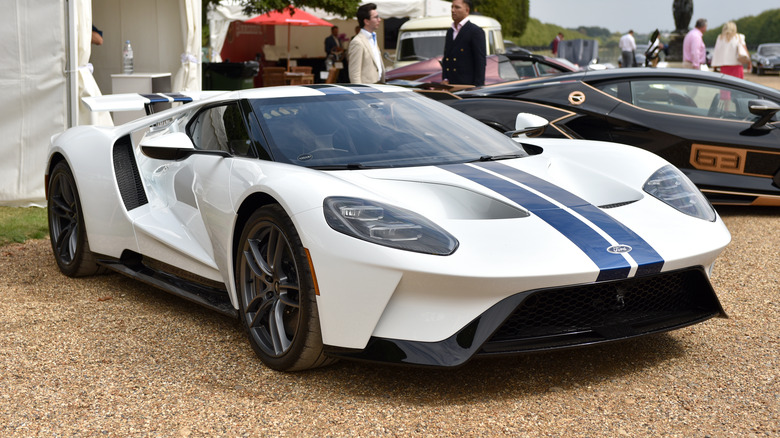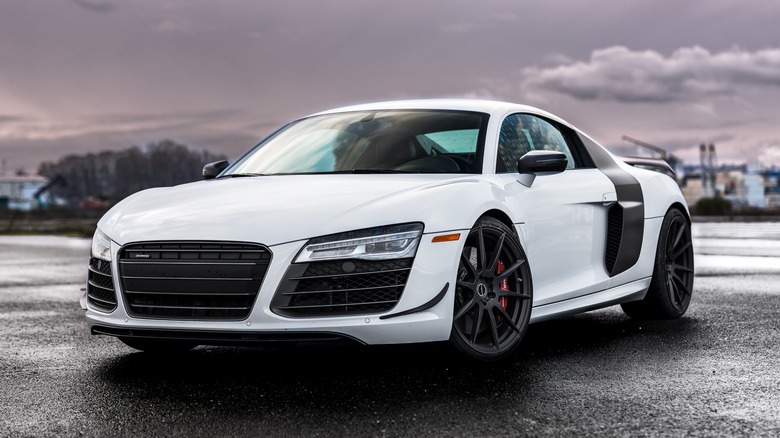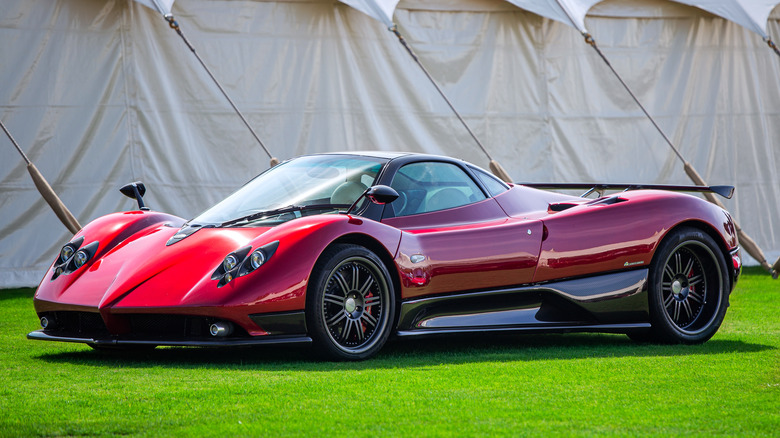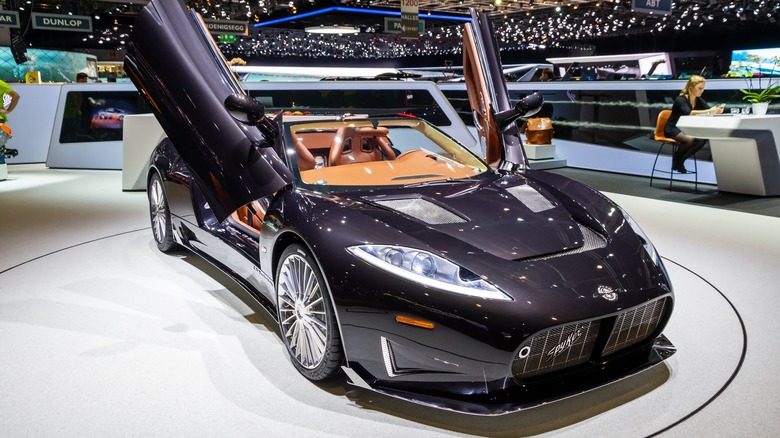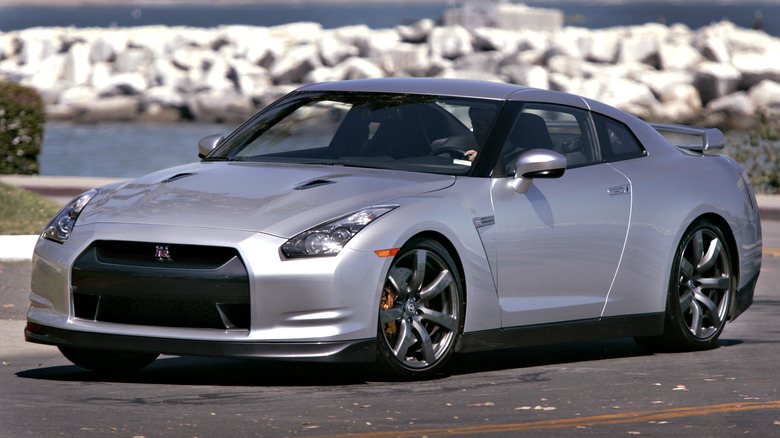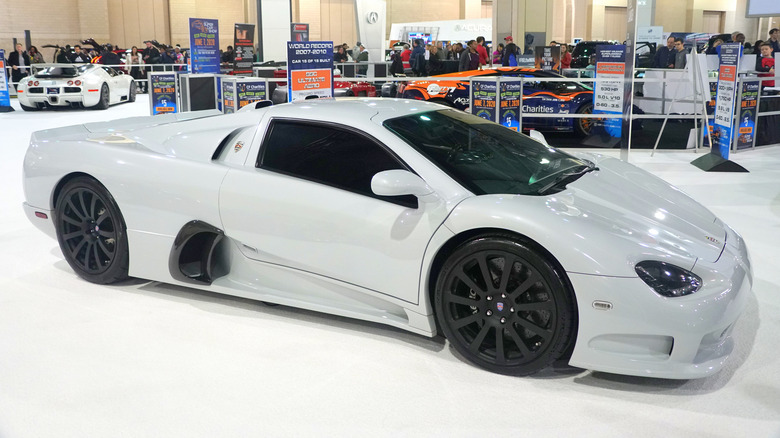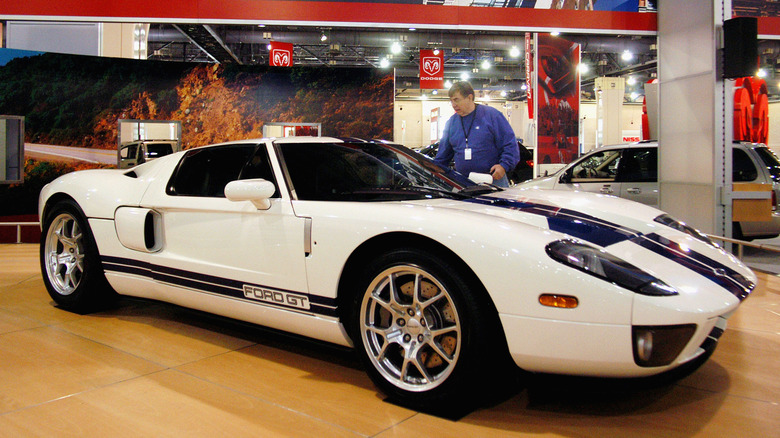The 6 Most Overlooked Exotic Cars Of The 00s
Exotic cars went through a bit of a boom period as the new millennium dawned just under a quarter century ago. The bullish stock market of the 1990s and the meteoric growth of speculative financial and real estate markets put billions of dollars of new money in the hands of people who were not hesitant to spend it on fast, flashy cars. Automakers saw this demand emerging and used the latest engine technology and high-strength, low-weight materials like carbon fiber and titanium to construct high-performance machines like the Bugatti Veyron, the Lamborghini Murcielago, and the Porsche Boxster — all of which were in production during the early 2000s.
Those supercars were celebrated in their time and are valued by collectors today, but there were plenty of others that came along during that same time period that didn't get quite as much attention when they were first released. Some of those cars can even be found on the secondhand market at relatively reasonable prices, in case you have some stock options that are about to vest and some space in your garage. Here are six of those overlooked exotics from the days when "The Fast and The Furious" was just a film with a single sequel and not a seemingly endless saga with 13 installments (and counting).
Audi R8
Although Audi has produced its share of high-performance machines in its more than 100 years in business, the four interlocking rings are not the first badge that comes to mind when the subject of exotic cars comes up. Until the early 2000s, Audi focused largely on cranking out reliable sedans, coupes, and wagons while also dedicating significant resources to its motorsports program.
That began to change in 1998 when the Volkswagen Group paid more than $100 million to acquire Lamborghini. Soon after, Audi sought to capitalize on its success at Le Mans by introducing the Le Mans Quattro concept car at the 2003 Frankfurt Auto Show. That concept merged with the R8 race car that had won the 24 Hours of Le Mans every year from 2000 through 2002; the new model debuted at the 2006 Paris Auto Show.
Little was changed between the concept Le Mans Quattro and the production version R8, except that the concept car's twin-turbo V10 engine was swapped out for a naturally aspirated 4.2 liter V8 that put out 414 horsepower and 317 pound-feet of torque. The 2007 R8 could go from zero-to-60 mph in 4.3 seconds and had a top speed of 187 mph.
In 2009, Audi added those two cylinders back to the R8's engine, replacing the V8 with a 5.2-liter V10 that shaved nearly a half second off the R8's zero-to-60 time and boosted the top speed to 196 mph. A lighter and more powerful R8 came in 2011, and Audi released a GT edition in 2023 with a 602 horsepower engine, rear-wheel drive, and a seven-speed automatic transmission.
Pagani Zonda
One of the fastest and most dramatic-styled supercars of the early 2000s came from a fairly obscure carmaker with humble beginnings. As a child in Argentina, Horacio Pagani was captivated by cars and became fascinated by reading books about how Leonardo da Vinci merged art and science. Pagani went on to work for Lamborghini as an engineer and later turned his attention to developing his own car, which he initially called "Fangio F1" in honor of the legendary Argentinian Formula 1 champion Juan Manuel Fangio.
After Fangio's death in 1995, Pagani rechristened the car the C12 and presented it at the 1999 Geneva Motor Show. The C12 had a 6.0 liter Mercedes engine that propelled the carbon-fiber body from zero-to-60 in 4.2 seconds and gave the C12 a top speed of 185 mph. The Zonda evolved into dozens of variants over the following two decades, including a bespoke model built specially for seven-time F1 champion Lewis Hamilton.
The final version of the Zonda, the Revolucion, appeared in 2013 with an 800-horsepower engine and an F1-inspired Drag Reduction System (DRS) on its rear wing. The Revolucion was truly track-ready, with a top speed of 233 mph and a zero-to-60 time of just 2.7 seconds.
Spyker C8 Spyder
Spyker was founded in 1880 and built the world's first six-cylinder, four-wheel drive car in 1903. The original company went bankrupt in 1925, but in 2000, Spyker returned with the C8 Spyder, presenting the roadster at the Birmingham Motor Show. Only 121 Spyders were made, making this one of the era's rarest models.
The Spyder was powered by an Audi twin-turbo 4.2 liter V8 that produced 525 horsepower. That motor was mated to a six-speed manual transmission with a long aluminum linkage bar that ran from the shift lever to the gearbox and was visible from the car's passenger compartment. This drivetrain could propel the Spyder from zero-to-60 in about 4.5 seconds, giving it a top speed of 187 mph.
The C8 remained in production until this year, even through Spyker's additional bankruptcies in 2014 and 2021 (the 2014 bankruptcy was overturned by a Dutch court the following year). The current variants of the C8 are the Preliator and the Aileron, both of which have aircraft-inspired controls, instrumentation, and styling to go along with their aviation industry monikers.
R35 Nissan GT-R
One of the more unassuming supercars in automotive history is the Nissan GT-R, a car that evolved from the Skyline GT-R, which Nissan introduced in 1969. Nissan dropped the Skyline badge in 2008, and that version of the GT-R, the R35, had a 473 horsepower twin-turbo V6 that was hand-built by one of four specially trained mechanics. That motor could slingshot the R35 GT-R from zero-to-60 mph in 3.6 seconds and to a top speed of 194 mph.
The R35 GT-R doesn't have the eye-catching lines of a Ferrari or a Pagani or the striking hand-crafted interior of a Spyker, but its zero-to-60 time is more than two seconds faster than that of a Lamborghini Countach and almost matches that of the Murcielago. The GT-R did get plenty of cinematic attention, however, appearing in dozens of movies, including several installments of the "Fast & Furious" franchise.
The model remains in production today; the 2024 version has a 3.8-liter twin-turbo V6 that produces 600 horsepower in the top-level GT-R NISMO variant.
SSC Ultimate Aero
The Shelby name has long been synonymous with speed; Carrol Shelby's Shelby Cobra was long regarded as the world's fastest production car. In 1998, Jerrod Shelby (no relation to Carroll) founded Shelby SuperCars; he later changed the company's name to SSC North America to avoid legal entanglements with Carrol Shelby's estate.
In 2004, SSC began testing prototypes of the Ultimate Aero, and in September 2007, the new supercar set a new land speed record of 256.14 mph. The original Ultimate Aero was powered by a Corvette C5-R V8 that put out more than 1,000 horsepower and 800 pound-feet of torque, but later versions were outfitted with a twin-turbo LS6 engine that was capable of a whopping 1,180 horsepower. The Ultimate Aero TT, as it was badged, could go from zero to 60 in 2.78 seconds and could reach a top speed of more than 257 mph. The Ultimate Aero TT is even rarer than the Spyker C8; only 24 were made.
SSC later followed that up with the Tuatara, a batmobile-inspired beast capable of either 1,350 or 1,750 horsepower, depending on the choice of fuel.
Ford GT
While many of the cars on this list came from tiny manufacturers of limited-run supercars or racing royalty like Ferrari and Audi, the automaker responsible for econoboxes — like the Escort and the Festiva — also produced one of the most impressive supercars of the early 21st Century. The Ford GT label was originally used on the legendary GT40 models from 1964 through 1969, then revived in 2004 on a car simply known as the GT. That low-slung beast invoked the styling of the original but had a supercharged 5.4 liter V8 that produced 550 horsepower and was able to bring the GT from a stop to 60 mph in 3.5 seconds.
The first generation GT stayed around through 2006, but only about 4,000 copies were produced in those three years. A second generation appeared in 2017, with a 3.5-liter twin-turbo V6 that produced almost 650 horsepower. Another update came in 2019, but the GT was discontinued after the 2023 model year following a production run of just 67 non-street-legal copies.
